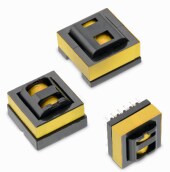Resonant transformer
For more details on this topic,
see Resonant inductive coupling.
For more details on this topic,
see Tesla coil § Resonant transformer.
A resonant transformer is a transformer in which
one or both winding has a capacitor across it and functions as a tuned
circuit. Used at radio
frequencies, resonant transformers can function as high Q factor bandmpass filters. The transformer winding have
either air or ferrite cores and the bandwidth can be adjusted by
varying the coupling (mutual
inductance). One common form is the IF (intermediate frequency) transformer, used in super heterodyne radio
receivers. They are also used in radio transmitters.
Resonant transformers are also used in electronic ballasts for gas discharge lamps, and high voltage power
supplies. They are also used in some types of switching power supplies. Here
the short-circuit inductance value
is an important parameter that determines the resonance frequency of the
resonant transformer. Often only secondary winding has a resonant capacitor (or
stray capacitance) and acts as a serial resonant tank circuit. When the
short-circuit inductance of the secondary side of the transformer is L sc and
the resonant capacitor (or stray capacitance) of the secondary side is Cr' The
resonance frequency ωs of 1' is as follows
{\displaystyle \omega _{s}={\frac {1}{\sqrt
{L_{sc}C_{r}}}}={\frac {1}{\sqrt {(1-k^{2})L_{s}C_{r}}}}}
The transformer is driven by a pulse or square wave for
efficiency, generated by an electronic oscillator circuit. Each pulse
serves to drive resonant sinusoidal oscillations in the tuned winding, and due
to resonance a high voltage can be developed across the secondary.
Applications:
·
Intermediate frequency (IF) transformer in super heterodyne
radio receiver
·
Tank transformers in radio
transmitters
·
Tesla
coil
·
CCFL
inverter
·
Oudin
coil (or Oudin resonator; named after its inventor Paul
Oudin)
·
D'Arsonval apparatus
·
Ignition
coil or induction
coil used in the ignition
system of a petrol
engine
·
Electrical breakdown and insulation testing of
high voltage equipment and cables. In the latter case, the transformer's
secondary is resonated with the cable's capacitance.
 Ferrite core power transformers are widely
used in switched-mode power supplies (SMPSs).
The powder core enables high-frequency operation, and hence much smaller
size-to-power ratio than laminated-iron transformers.
Ferrite core power transformers are widely
used in switched-mode power supplies (SMPSs).
The powder core enables high-frequency operation, and hence much smaller
size-to-power ratio than laminated-iron transformers.

